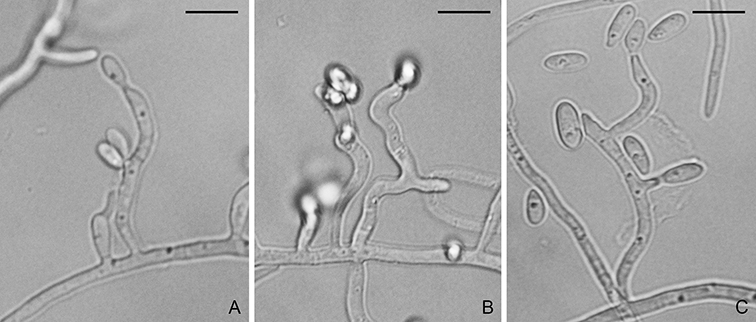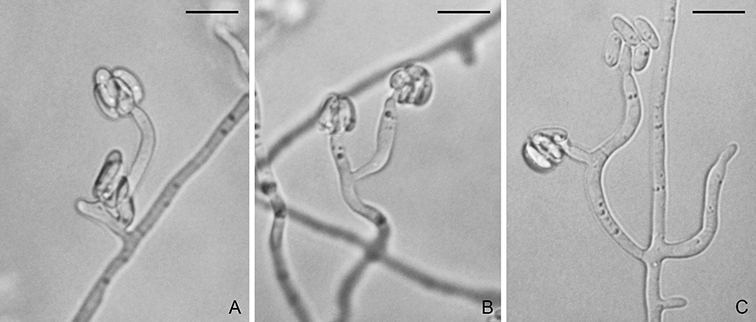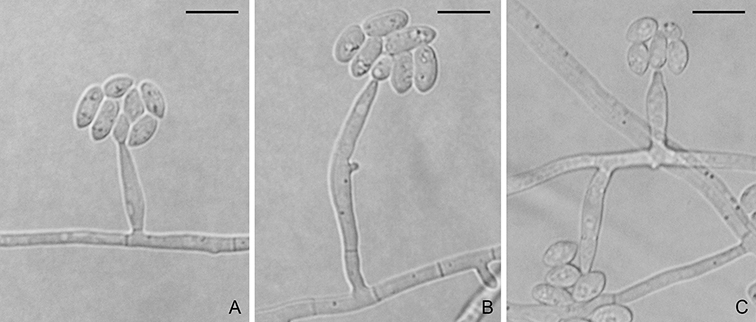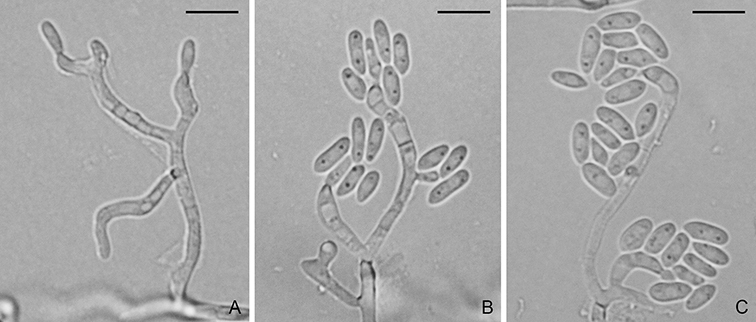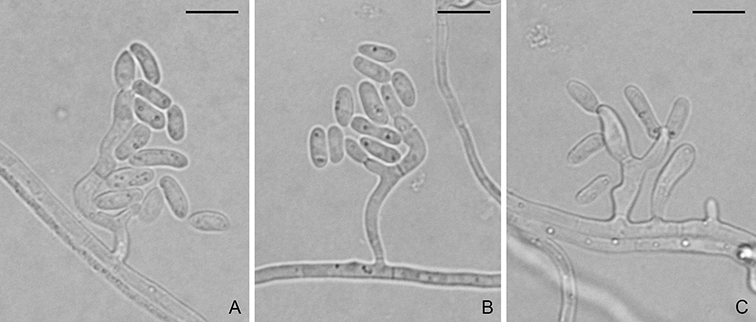Post Views:
1,270
Use Nakataea Hara 1939 (asexual name, A) rather than Magnaporthe R.A. Krause & R.K. Webster 1972 (sexual name, S)
The rice blast fungus has conidial (asexual) and sexual morphs and the rice stem rot fungus produces sclerotial (asexual), conidial (asexual) and sexual morphs. Historically, such pleomorphy added to the difficulty in resolving taxonomic and nomenclatural problems associated with these species.
In 1877, Cattaneo (1877) first named the rice stem rot pathogen as Sclerotium oryzae based on its sclerotial morph. In the same paper he also described Leptosphaeria salvinii, which was later recognized as the sexual morph of the same fungus (Tullis 1933). Hara (1939) named the conidial morph of the species Nakataea sigmoidea. Krause & Webster (1972) established a new sexual genus Magnaporthe to accommodate the rice stem rot pathogen as Magnaporthe salvinii. Sclerotium and Leptosphaeria currently belong in Basidiomycota and Dothideomycetes respectively (Xu et al. 2010), and are therefore not applicable to this sordariomycetous species. Nakataea and Magnaporthe are congeneric and their type species, Nakataea sigmoidea and Magnaporthe salvinii refer to the same species (Krause & Webster 1972). Based on Article 59.1 of the Melbourne Code (McNeill et al. 2012), which considers names for sexual and asexual morphs equally, Luo et al. (2013) proposed a new combination for the rice stem rot fungus as Nakataea oryzae (Catt.) J. Luo & N. Zhang, which is the combination of the oldest legitimate genus and species epithet. The recommendation of using asexual morph-typified Nakataea over sexual morph-typified Magnaporthe needs approval by the Nomenclature Committee for Fungi (NCF).
Use Pyricularia Sacc. 1880 (A) rather than Magnaporthe R.A. Krause & R.K. Webster 1972 (S)
In 1880, Saccardo established the asexual genus Pyricularia based on P. grisea on crabgrass. The rice isolates were designated as P. oryzae in 1892 by Cavara, which now is known as the rice blast fungus. Since then, over 50 species have been listed as Pyricularia that cause blast diseases of various monocot plants.
The sexual morph of Pyricularia was first observed in 1970 from laboratory crossing experiments and it was believed to belong to Magnaporthe because of the similarity in ascospore morphology (Hebert 1970, Couch & Kohn 2002). However, recent phylogenetic and phylogenomic analyses clearly demonstrated that the sexual genus Magnaporthe is polyphyletic. The rice blast fungus is not congeneric to the type species of Magnaporthe, M. salvinii, and the placement of the rice blast fungus in Magnaporthe was based on an incorrect morphological identification (Zhang et al. 2011, Luo & Zhang 2013, Luo et al. 2014, Murata et al. 2014, Luo et al. 2015b). This is a taxonomic issue but not a nomenclatural one because the generic names Magnaporthe and Pyricularia are not congeneric and do not compete for priority.
Both Pyricularia and Magnaporthe are widely used generic names, and the rice blast fungus is an economically and scientifically important species that deserves much caution. The Pyricularia/Magnaporthe Working Group has considered the possibility of conserving the name Magnaporthe over Pyricularia. However, such conservation would require an unusual change of the type for the genus Magnaporthe and would cause an excessive number of name changes for those species currently placed in Pyricularia.
The asexual genus Pyricularia is the correct name for the blast fungus, which corresponds well with pathogenicity, and ecological and evolutionary features. Therefore, we propose to use Pyricularia oryzae for the rice blast fungus, but its synonym Magnaporthe oryzae can continue to be included in publications as Pyricularia oryzae (syn. Magnaporthe oryzae). This will help to bridge the literature and knowledge gap for this important species.
Use Clasterosporium Schwein. 1832 (A) rather than Clasterosphaeria Sivan. 1984 (S)
The genus Clasterosphaeria based on C. cyperi was established for the sexual morph of Clasterosporium cyperi M.B. Ellis 1958 and includes only two names. The generic name Clasterosporium based on C. caricinum includes 158 names, many of which have been placed in other genera. Whether or not Clasterosphaeria cyperi is congeneric with Clasterosporium caricinum is not known, although this seems likely given that both occur on members of the Cyperaceae. If this is the case, use of the older, more commonly used generic name Clasterosporium is recommended.
Use Gaeumannomyces Arx & D.L. Oliver 1952 (S) rather than Harpophora Gams 2000 (A)
The genus Gaeumannomyces based on G. graminis has long been used for the cause of take-all of wheat disease (Walker 1972). Harpophora was established for phialophora-like species that were known to be the asexual morphs related to Gaemannomyces and Magnaporthe but did not produce a sexual morph (Gams 2000). With the change to one name, Harpophora based on H. radicicola is considered a synonym of Gaeumannomyces because it was shown phylogenetically to belong in that genus, thus Gaeumannomyces and Harpophora are synonyms (Luo et al. 2015b). Given the greater number of species, priority, and numerous reports, use of Gaeumannomyces is recommended.
Use Omnidemptus Cannon & Alcorn 1994 (S) rather than Mycoleptodiscus Ostaz. 1968 (A)
The monotypic genus Omnidemptus includes only O. affinis, which Cannon & Alcorn (1994) considered as the sexual morph of Mycoleptodiscus affinis. The genus Mycoleptodiscus based on M. terrestris includes 17 species, some of which are important plant pathogens and medically significant fungi. However, based on internal transcribed spacer and the 28S rRNA gene sequence data, Omnidemptus is not congeneric with Mycoleptodiscus, and several Mycoleptodiscus species including the type belong in Dothideomycetes rather than Magnaporthales in Sordariomycetes. Therefore, we exclude Mycoleptodiscus from the generic list of Magnaporthales and recommend using Omnidemptus.
Reference: Zhang N, Luo J, Rossman A, Aoki T, Chuma I, Crous PW, Dean R, de Vries RP, Donofrio N, Hyde KD, Lebrun M-H, Talbot NJ, Tharreau D, Tosa Y, Valent B, Wang Z-H, Xu J-R. 2016. Generic names in Magnaporthales. IMA Fungus 7:155-159.

